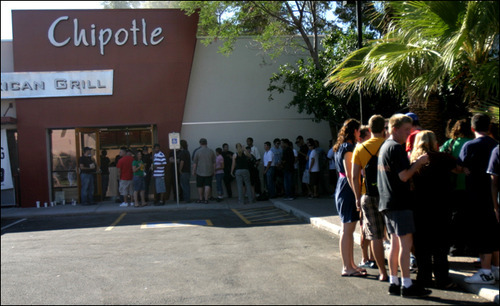I Am A Designer. You Are An Architect. (Blurred Lines)
In What Is This Thing Called Design Criticism - Part 1, Michael Rock made one comment that gave me pause for thought:
“The evolution of display technology has fundamentally changed the relationship between the designer, the architect, and the city.”
Initially this comment sparked some simple questions like, "What is the designer’s role?” versus “What is the architect’s role?” And the city? “Is that the product of design? Or is that supposed to denote the audience, or end user?”
ARCHITECT OR DESIGNER?
Specifically, I began thinking about the trend of Fast-Casual Dining that has evolved over the last 10 or 15 years. Conceptual formats vary from restaurant to restaurant when it comes to any given part of an experience - the display of menus, the process of ordering, payment, receiving or retrieving ones order, dining, and departure. Think about your experiences at, La Madeleine versus Quiznos. Freebirds versus Tarka. Even at the same restaurant an experience may vary between time of visit or mode of dining (delivery, takeout, dine-in).
At Chipotle, for example, on a slow day a diner might zip right through the line and burrito building process, while during a crowded lunch hour when lines are long, team members approach diners to complete ordering and payment to try and speed up the process.
Some of these conceptual formats work quite well - others, not so much. One particularly awful format is the burger restaurant Hopdoddy. In the spirit of innovation and novelty, they’ve tried to adopt a twist on the fast casual format which simply does not work. Here’s Hopdoddy’s "novel” twist:
- A diner has to wait outside in line (in 100+ degree full sun temps at times), to be considered for the reservation line near the door - Acceptance is determined on restaurant capacity, party size and seating availability
- Once in the reservation line, a party must wait for a table to become available in order to wait in yet a third line
- Oh glorious third line! Where I get to place my order and pay! There will be food soon.
- But wait, there are more lines at the soda fountain and bar. At least at the end of all these lines a diner is guaranteed to have a seat available.
- OMG I’m sitting at a table - where’s my burger? Where’s my burger? Where’s my burger?
While this wacko “innovative” process solves one problem - getting through line and being unable to find a table to sit at, it creates an overly-cumbersome experience that some people actively avoid. The goal should be to solve existing pain points without creating more problems - sometimes, as this wired article points out - innovation isn’t enough.
Design is the intentional crafting of a relationship between experience and audience. To know when to abstain from that craft is design too.
— John Maeda (@johnmaeda)June 12, 2014
BLURRED LINES
This example of conceptual dining formats sparked a domino effect of questions: Who comes up with these fast-casual dining concepts? An architect? Environmental designer? Experience designer? A chef? Restauranteur? Furthermore, how do we delineate the responsibilities, for example, of an architect versus a designer? Where does one role end and another begin?
Who owns the concept?
Who should I direct my criticism toward?
Is the outcome a living thing that evolves over time? Is it ever really final? In the case of a busy Chipotle or Hopdoddy, where there is certainly room for improvement, how do designers affect change across a potentially goliath organization?
Issues that both designers and architects deal with are strikingly parallel. It seems logical that the design practice has appropriated terms from architecture in recent years, and this alone connotes similarity between roles and responsibilities at a macro level. In the visual essay, What is Design? A Manifesto… The first point states,
“Autonomous design is at best, a myth… designers ought to embrace the discipline’s communal and contingent nature.”
Toward the end of the manifesto, point seven states,
“At its best, design’s cultural value - as opposed to its commercial value - functions as an abundance, a resource to be shared.”
Despite obvious distinctions, there is certainly a convergence between the two fields that our disciplines may eventually need to mete out, thus underscoring the importance of cross-disciplinary collaboration. How so?
ON DEVELOPING A MORE HOLISTIC DESIGN PRACTICE
As the constructs of design output become increasingly complex, and more screens are bring added to the mix of media outlets, the role of the designer has become fragmented, specialized, and focused on not only various parts of the process, but specific outcomes which are parts of a, sometimes disjointed experience or end product. While this degree of specialization is certainly necessary, this fragmentation has caused a fatal flaw in contemporary design practice - on the whole, practitioners have lost sight of the bigger picture. [Pun intended.]
It seems that tangential arts and disciplines are recognizing the value of the design process, including special skills and perspective a trained designer brings to the table.
“Design plays such a crucial role because it represents the intentional crafting of a relationship between experience and audience, and is the medium through which consumers engage with the brand. Designers are becoming inventors, because they’re driving business concepts, not just visualizing others’ concepts.
John Maeda, Forrester CX Forum Day Two: Brands Need to Break Out of Old Ecosystems
Consider for a moment the emerging field of Experience Design. We are seeing roles pop up with titles such as: Information Architect, User Experience (UX) Researcher, UX Designer, Customer Experience (CX), Experience Director, Technical Architect, the list goes on. What is it about the design craft that makes it so malleable, flexible, versatile, and complementary to other disciplines?
This will be the focus of my next blog - Beyond the Screen: A Holistic Approach to Design.

